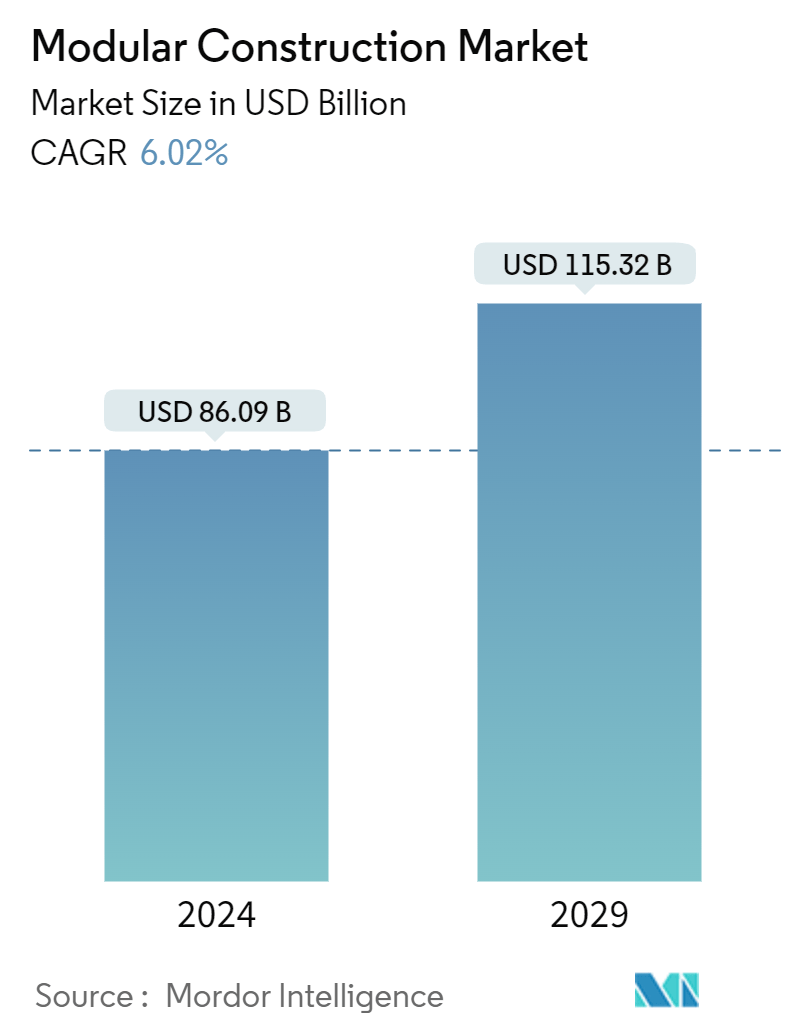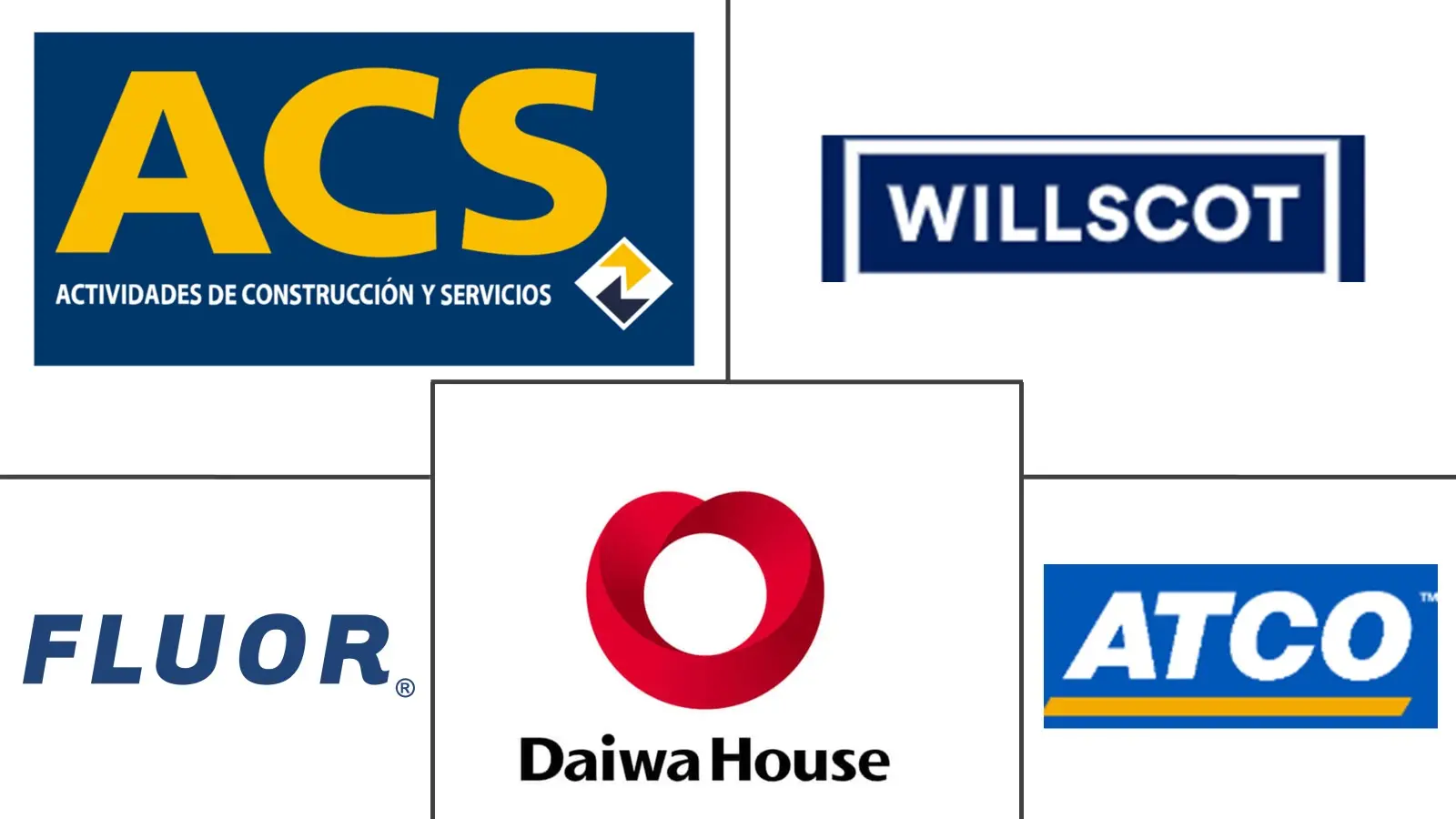Market Size of Modular Construction Industry

| Study Period | 2019 - 2029 |
| Market Size (2024) | USD 86.09 Billion |
| Market Size (2029) | USD 115.32 Billion |
| CAGR (2024 - 2029) | 6.02 % |
| Fastest Growing Market | Asia Pacific |
| Largest Market | Asia Pacific |
Major Players
*Disclaimer: Major Players sorted in no particular order |
Modular Construction Market Analysis
The Modular Construction Market size is estimated at USD 86.09 billion in 2024, and is expected to reach USD 115.32 billion by 2029, growing at a CAGR of 6.02% during the forecast period (2024-2029).
During the COVID-19 pandemic, there was a negative impact on the modular construction market globally as factories and manufacturing facilities were shut down, which stopped the production of modules or pre-engineered building units. Additionally, nationwide lockdowns in several countries and strict social distancing measures affected the construction industry. However, the modular construction market has recovered from the pandemic and is growing significantly.
- In the short term, increasing demand for modular construction from developed economies and supportive government initiatives are expected to propel the market's growth.
- Conversely, supply chain challenges, shortage of skilled labor, and adverse macroeconomic conditions are expected to hinder growth.
- However, the growing global housing crisis is expected to create opportunities in the market during the forecast period.
- Asia-Pacific is expected to dominate the market and witness the highest annual growth rate during the forecast period.
Modular Construction Industry Segmentation
Modular construction involves delivering and assembling pre-fabricated engineered building units on the construction site. The construction process of modular buildings is faster than the conventional process, as it requires less time and offers greater flexibility and improved air quality.
The modular construction market is segmented by construction, material, end-user industry, and geography. By construction, the market is segmented into permanent modular and relocatable modular. The market is segmented by materials: steel, concrete, wood, and plastic. By end-user industry, the market is segmented into commercial, industrial/institutional, and residential. The report also covers the market sizes and forecasts for the modular construction market in 15 countries across major regions. For each segment, the market sizing and forecasts are done based on value (USD).
| Construction | |
| Permanent Modular | |
| Relocatable Modular |
| Material | |
| Steel | |
| Concrete | |
| Wood | |
| Plastic |
| End-user Industry | |
| Commercial | |
| Industrial/institutional | |
| Residential |
| Geography | ||||||||
| ||||||||
| ||||||||
| ||||||||
| ||||||||
|
Modular Construction Market Size Summary
The modular construction market is poised for significant growth, driven by increasing demand from the construction industry, particularly in the Asia-Pacific region. This growth is attributed to the region's expanding residential and commercial construction sectors, with countries like China and India leading the charge. The adoption of modular construction techniques is seen as a cost-effective solution, offering opportunities for market expansion despite challenges such as rising logistics costs and transportation risks. The Asia-Pacific region not only dominates the global market in terms of consumption but also stands as the fastest-growing market, supported by substantial investments in infrastructural projects and government initiatives aimed at boosting affordable housing.
In the United States and Europe, the industrial and institutional sectors are the largest segments within the modular construction market. The United States has witnessed a surge in public and educational construction spending, which has fueled demand for modular construction products. Similarly, Europe has seen increased investments in institutional projects, such as the construction of energy-efficient buildings. Major players in the market, including Skanska, Bouygues Construction, and WillScot Mobile Mini Holdings Corp., are actively involved in various projects, including joint ventures and contracts for residential developments. These factors collectively contribute to a positive outlook for the modular construction market, with expectations of continued growth and innovation in the coming years.
Modular Construction Market Size - Table of Contents
-
1. MARKET DYNAMICS
-
1.1 Drivers
-
1.1.1 Increasing Demand for Modular Construction from Developed Economies
-
1.1.2 Supportive Government Initiatives for Modular Construction
-
-
1.2 Restraints
-
1.3 Industry Value Chain Analysis
-
1.4 Porter's Five Forces Analysis
-
1.4.1 Bargaining Power of Suppliers
-
1.4.2 Bargaining Power of Buyers
-
1.4.3 Threat of New Entrants
-
1.4.4 Threat of Substitute Products and Services
-
1.4.5 Degree of Competition
-
-
-
2. MARKET SEGMENTATION (Market Size in Value)
-
2.1 Construction
-
2.1.1 Permanent Modular
-
2.1.2 Relocatable Modular
-
-
2.2 Material
-
2.2.1 Steel
-
2.2.2 Concrete
-
2.2.3 Wood
-
2.2.4 Plastic
-
-
2.3 End-user Industry
-
2.3.1 Commercial
-
2.3.2 Industrial/institutional
-
2.3.3 Residential
-
-
2.4 Geography
-
2.4.1 Asia-Pacific
-
2.4.1.1 China
-
2.4.1.2 India
-
2.4.1.3 Japan
-
2.4.1.4 South Korea
-
2.4.1.5 Rest of Asia-Pacific
-
-
2.4.2 North America
-
2.4.2.1 United States
-
2.4.2.2 Canada
-
2.4.2.3 Mexico
-
-
2.4.3 Europe
-
2.4.3.1 Germany
-
2.4.3.2 United Kingdom
-
2.4.3.3 France
-
2.4.3.4 Italy
-
2.4.3.5 Benelux Countries
-
2.4.3.6 Rest of Europe
-
-
2.4.4 South America
-
2.4.4.1 Brazil
-
2.4.4.2 Argentina
-
2.4.4.3 Rest of South America
-
-
2.4.5 Middle East and Africa
-
2.4.5.1 Saudi Arabia
-
2.4.5.2 South Africa
-
2.4.5.3 Rest of Middle East and Africa
-
-
-
Modular Construction Market Size FAQs
How big is the Modular Construction Market?
The Modular Construction Market size is expected to reach USD 86.09 billion in 2024 and grow at a CAGR of 6.02% to reach USD 115.32 billion by 2029.
What is the current Modular Construction Market size?
In 2024, the Modular Construction Market size is expected to reach USD 86.09 billion.

